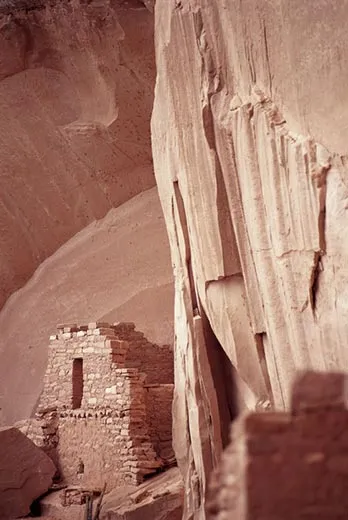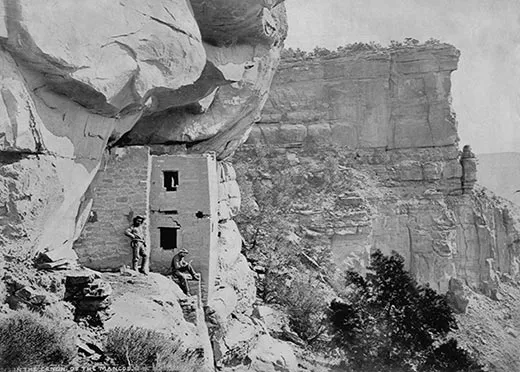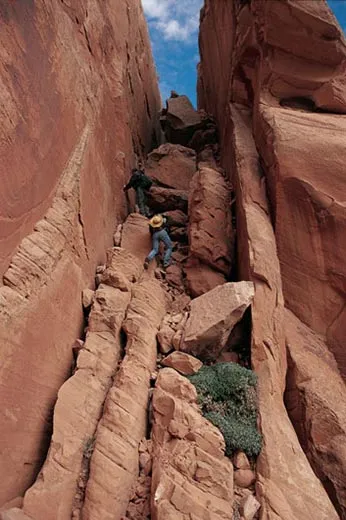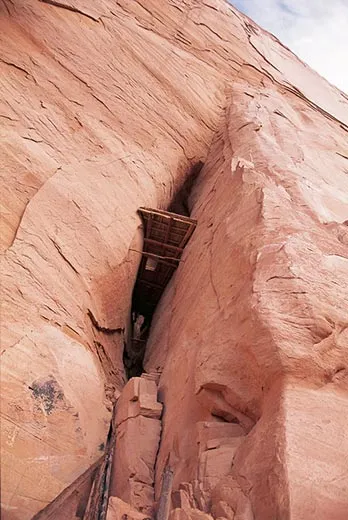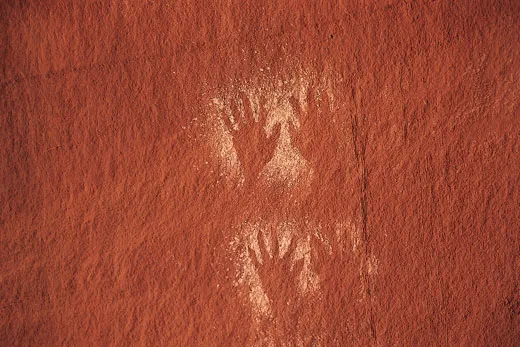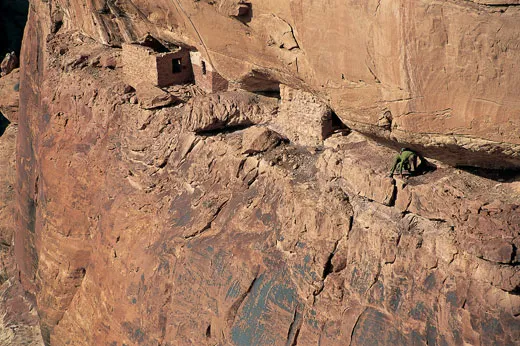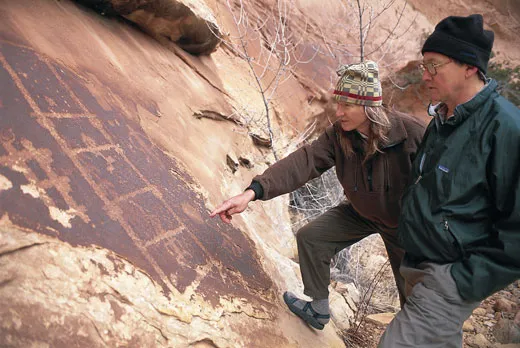Riddles of the Anasazi
What awful event forced the Anasazi to flee their homeland, never to return?
The four of us walked slowly down the deep, narrow canyon in southern Utah. It was midwinter, and the stream that ran alongside us was frozen over, forming graceful terraces of milky ice. Still, the place had a cozy appeal: had we wanted to pitch camp, we could have selected a grassy bank beside the creek, with clear water running under the skin of ice, dead cottonwood branches for a fire, and—beneath the 800-foot-high rock walls—shelter from the wind.
More than seven centuries ago, however, the last inhabitants of the canyon had made quite a different decision about where to live. As we rounded a bend along the trail, Greg Child, an expert climber from Castle Valley, Utah, stopped and looked upward. “There,” he said, pointing toward a nearly invisible wrinkle of ledge just below the canyon rim. “See the dwellings?” With binoculars, we could just make out the facades of a row of mud-and-stone structures. Up we scrambled toward them, gasping and sweating, careful not to dislodge boulders the size of small cars that teetered on insecure perches. At last, 600 feet above the canyon floor, we arrived at the ledge.
The airy settlement that we explored had been built by the Anasazi, a civilization that arose as early as 1500 B.C. Their descendants are today’s Pueblo Indians, such as the Hopi and the Zuni, who live in 20 communities along the Rio Grande, in New Mexico, and in northern Arizona. During the 10th and 11th centuries, ChacoCanyon, in western New Mexico, was the cultural center of the Anasazi homeland, an area roughly corresponding to the Four Corners region where Utah, Colorado, Arizona and New Mexico meet. This 30,000-square-mile landscape of sandstone canyons, buttes and mesas was populated by as many as 30,000 people. The Anasazi built magnificent villages such as ChacoCanyon’s Pueblo Bonito, a tenth-century complex that was as many as five stories tall and contained about 800 rooms. The people laid a 400-mile network of roads, some of them 30 feet wide, across deserts and canyons. And into their architecture they built sophisticated astronomical observatories.
For most of the long span of time the Anasazi occupied the region now known as the Four Corners, they lived in the open or in easily accessible sites within canyons. But about 1250, many of the people began constructing settlements high in the cliffs—settlements that offered defense and protection. These villages, well preserved by the dry climate and by stone overhangs, led the Anglo explorers who found them in the 1880s to name the absent builders the Cliff Dwellers.
Toward the end of the 13th century, some cataclysmic event forced the Anasazi to flee those cliff houses and their homeland and to move south and east toward the Rio Grande and the Little Colorado River. Just what happened has been the greatest puzzle facing archaeologists who study the ancient culture. Today’s Pueblo Indians have oral histories about their peoples’ migration, but the details of these stories remain closely guarded secrets. Within the past decade, however, archaeologists have wrung from the pristine ruins new understandings about why the Anasazi left, and the picture that emerges is dark. It includes violence and warfare—even cannibalism—among the Anasazi themselves. “After about A.D. 1200, something very unpleasant happens,” says University of Colorado archaeologist Stephen Lekson. “The wheels come off.”
This past January and February, Greg Child, Renée Globis, Vaughn Hadenfeldt and I explored a series of canyons in southeast Utah and northern Arizona, seeking the most inaccessible Anasazi ruins we could find. I have roamed the Southwest for the past 15 years and have written a book about the Anasazi. Like Greg, who has climbed Everest and K2, Renée is an expert climber; she lives in Moab, Utah, and has ascended many desert spires and cliffs. Vaughn, a tour guide from Bluff, Utah, has worked on a number of contract excavations and rock art surveys in southeastern Utah.
We were intrigued by the question of why the villages were built high in the cliffs, but we were equally fascinated by the “how”—how the Anasazi had scaled the cliffs, let alone lived there. During our outings, we encountered ruins that we weren’t sure we could reach even with ropes and modern climbing gear, the use of which is prohibited at such sites. Researchers believe the Anasazi clambered up felled tree trunks that were notched by stone axes to form minuscule footholds. These log ladders were often propped on ledges hundreds of feet off the ground. (Some of the ladders are still in place.) But they would not have been adequate to reach several of the dwellings we explored. I believe that archaeologists—who are usually not rock climbers—have underestimated the skill and courage it took to live among the cliffs.
The buildings that Greg had spotted were easier to get to than most of the sites we explored. But it wasn’t so easy to navigate the settlement itself. As we walked the ledge of the ruin, the first structure we came to was a five-foot-tall stone wall. Four small loopholes—three-inch-wide openings in the wall—would have allowed sentries to observe anyone who approached. Behind this entry wall stood a sturdy building, its roof still intact, that adjoined a granary littered with 700-yearold, perfectly preserved corncobs. Farther along the narrow ledge, we turned a sharp corner only to be blocked by a second ruined wall. We climbed over it and continued. Twice we were forced to scuttle on our hands and knees as the cliff above swelled toward us, pinching down on the ledge like the jaws of a nutcracker. Our feet gripped the edge of the passage: one careless lurch meant certain death. Finally the path widened, and we came upon four splendidly masoned dwellings and another copious granary. Beneath us, the cliff swooped 150 feet down, dead vertical to a slope that dropped another 450 feet to the canyon floor. The settlement, once home to perhaps two families, seemed to exude paranoia, as if its builders lived in constant fear of attack. It was hard to imagine elders and small children going back and forth along such a dangerous passage. Yet the ancients must have done just that: for the Anasazi who lived above that void, each foray for food and water must have been a perilous mission.
Despite the fear that apparently overshadowed their existence, these last canyon inhabitants had taken the time to make their home beautiful. The outer walls of the dwellings were plastered with a smooth coat of mud, and the upper facades painted creamy white. Faint lines and hatching patterns were incised into the plaster, creating two-tone designs. The stone overhang had sheltered these structures so well that they looked as though they had been abandoned only within the past decade—not 700 years ago.
Vertiginous cliff dwellings were not the Anasazi’s only response to whatever threatened them during the 1200s; in fact, they were probably not all that common in the culture. This became apparent a few days later when Vaughn and I, leaving our two companions, visited Sand Canyon Pueblo in southwest Colorado, more than 50 miles east of our Utah prowlings. Partially excavated between 1984 and 1993 by the not-for-profit Crow Canyon Archaeological Center, the pueblo comprised 420 rooms, 90 to 100 kivas (underground chambers), 14 towers and several other buildings, all enclosed by a stone wall. Curiously, this sprawling settlement, whose well-thought-out architecture suggests the builders worked from a master plan, was created and abandoned in a lifetime, between 1240 and about 1285. Sand Canyon Pueblo looks nothing like Utah’s wildly inaccessible cliff dwellings. But there was a defense strategy built into the architecture nevertheless. “In the late 13th century,” says archaeologist William Lipe of Washington State University, “there were 50 to 75 large villages like SandCanyon in the Mesa Verde, Colorado, region—canyon-rim sites enclosing a spring and fortified with high walls. Overall, the best defense plan against enemies was to aggregate in bigger groups. In southern Utah, where the soil was shallow and food hard to come by, the population density was low, so joining a big group wasn’t an option. They built cliff dwellings instead.”
What drove the Anasazi to retreat to the cliffs and fortified villages? And, later, what precipitated the exodus? For a long time, experts focused on environmental explanations. Using data from tree rings, researchers know that a terrible drought seized the Southwest from 1276 to 1299; it is possible that in certain areas there was virtually no rain at all during those 23 years. In addition, the Anasazi people may have nearly deforested the region, chopping down trees for roof beams and firewood. But environmental problems don’t explain everything. Throughout the centuries, the Anasazi weathered comparable crises—a longer and more severe drought, for example, from 1130 to 1180—without heading for the cliffs or abandoning their lands.
Another theory, put forward by early explorers, speculated that nomadic raiders may have driven the Anasazi out of their homeland. But, says Lipe, “There’s simply no evidence [of nomadic tribes in this area] in the 13th century. This is one of the most thoroughly investigated regions in the world. If there were enough nomads to drive out tens of thousands of people, surely the invaders would have left plenty of archaeological evidence.”
So researchers have begun to look for the answer within the Anasazi themselves. According to Lekson, two critical factors that arose after 1150—the documented unpredictability of the climate and what he calls “socialization for fear”—combined to produce long-lasting violence that tore apart the Anasazi culture. In the 11th and early 12th centuries there is little archaeological evidence of true warfare, Lekson says, but there were executions. As he puts it, “There seem to have been goon squads. Things were not going well for the leaders, and the governing structure wanted to perpetuate itself by making an example of social outcasts; the leaders executed and even cannibalized them.” This practice, perpetrated by ChacoCanyon rulers, created a society-wide paranoia, according to Lekson’s theory, thus “socializing” the Anasazi people to live in constant fear. Lekson goes on to describe a grim scenario that he believes emerged during the next few hundred years. “Entire villages go after one another,” he says, “alliance against alliance. And it persists well into the Spanish period.” As late as 1700, for instance, several Hopi villages attacked the Hopi pueblo of Awatovi, setting fire to the community, killing all the adult males, capturing and possibly slaying women and children, and cannibalizing the victims. Vivid and grisly accounts of this massacre were recently gathered from elders by NorthernArizonaUniversity professor and Hopi expert Ekkehart Malotki.
Until recently, because of a popular and ingrained perception that sedentary ancient cultures were peaceful, archaeologists have been reluctant to acknowledge that the Anasazi could have been violent. As University of Illinois anthropologist Lawrence Keeley argues in his 1996 book, War Before Civilization, experts have ignored evidence of warfare in preliterate or precontact societies.
During the last half of the 13th century, when war apparently came to the Southwest, even the defensive strategy of aggregation that was used at SandCanyon seems to have failed. After excavating only 12 percent of the site, the CrowCanyonCenter teams found the remains of eight individuals who met violent deaths—six with their skulls bashed in—and others who might have been battle victims, their skeletons left sprawling. There was no evidence of the formal burial that was the Anasazi norm—bodies arranged in a fetal position and placed in the ground with pottery, fetishes and other grave goods.
An even more grisly picture emerges at Castle Rock, a butte of sandstone that erupts 70 feet out of the bedrock in McElmoCanyon, some five miles southwest of SandCanyon. I went there with Vaughn to meet Kristin Kuckelman, an archaeologist with the CrowCanyonCenter who co-led a dig at the base of the butte.Here, the Anasazi crafted blocks of rooms and even built structures on the butte’s summit. Crow Canyon Center archaeologists excavated the settlement between 1990 and 1994. They detected 37 rooms, 16 kivas and nine towers, a complex that housed perhaps 75 to 150 people. Tree-ring data from roof beams indicate that the pueblo was built and occupied from 1256 to 1274—an even shorter period than Sand Canyon Pueblo existed. “When we first started digging here,” Kuckelman told me, “we didn’t expect to find evidence of violence. We did find human remains that were not formally buried, and the bones from individuals were mixed together. But it wasn’t until two or three years into our excavations that we realized something really bad happened here.”
Kuckelman and her colleagues also learned of an ancient legend about Castle Rock. In 1874, John Moss, a guide who had spent time among the Hopi, led a party that included photographer William Henry Jackson through McElmoCanyon. Moss related a story told to him, he said, by a Hopi elder; a journalist who accompanied the party published the tale with Jackson’s photographs in the New York Tribune. About a thousand years ago, the elder reportedly said, the pueblo was visited by savage strangers from the north. The villagers treated the interlopers kindly, but soon the newcomers “began to forage upon them, and, at last, to massacre them and devastate their farms,” said the article. In desperation, the Anasazi “built houses high upon the cliffs, where they could store food and hide away ’til the raiders left.” Yet this strategy failed. A monthlong battle culminated in carnage, until “the hollows of the rocks were filled to the brim with the mingled blood of conquerors and conquered.” The survivors fled south, never to return.
By 1993, Kuckelman’s crew had concluded that they were excavating the site of a major massacre. Though they dug only 5 percent of the pueblo, they identified the remains of at least 41 individuals, all of whom probably died violently. “Evidently,” Kuckelman told me, “the massacre ended the occupation of Castle Rock.”
More recently, the excavators at Castle Rock recognized that some of the dead had been cannibalized. They also found evidence of scalping, decapitation and “face removing”—a practice that may have turned the victim’s head into a deboned portable trophy.
Suspicions of Anasazi cannibalism were first raised in the late 19th century, but it wasn’t until the 1970s that a handful of physical anthropologists, including Christy Turner of Arizona State University, really pushed the argument. Turner’s 1999 book, Man Corn, documents evidence of 76 different cases of prehistoric cannibalism in the Southwest that he uncovered during more than 30 years of research. Turner developed six criteria for detecting cannibalism from bones: the breaking of long bones to get at marrow, cut marks on bones made by stone knives, the burning of bones, “anvil abrasions” resulting from placing a bone on a rock and pounding it with another rock, the pulverizing of vertebrae, and “pot polishing”—a sheen left on bones when they are boiled for a long time in a clay vessel. To strengthen his argument, Turner refuses to attribute the damage on a given set of bones to cannibalism unless all six criteria are met.
Predictably, Turner’s claims aroused controversy. Many of today’s Pueblo Indians were deeply offended by the allegations, as were a number of Anglo archaeologists and anthropologists who saw the assertions as exaggerated and part of a pattern of condescension toward Native Americans. Even in the face of Turner’s evidence, some experts clung to the notion that the “extreme processing” of the remains could have instead resulted from, say, the post-mortem destruction of the bodies of social outcasts, such as witches and deviants. Kurt Dongoske, an Anglo archaeologist who works for the Hopi, told me in 1994, “As far as I’m concerned, you can’t prove cannibalism until you actually find human remains in human coprolite [fossilized excrement].”
A few years later, University of Colorado biochemist Richard Marlar and his team did just that. At an Anasazi site in southwestern Colorado called CowboyWash, excavators found three pit houses—semi-subterranean dwellings—whose floors were littered with the disarticulated skeletons of seven victims. The bones seemed to bear most of Christy Turner’s hallmarks of cannibalism. The team also found coprolite in one of the pit houses. In a study published in Nature in 2000, Marlar and his colleagues reported the presence in the coprolite of a human protein called myoglobin, which occurs only in human muscle tissue. Its presence could have resulted only from the consumption of human flesh. The excavators also noted evidence of violence that went beyond what was needed to kill: one child, for instance, was smashed in the mouth so hard with a club or a stone that the teeth were broken off. As Marlar speculated to ABC News, defecation next to the dead bodies 8 to 16 hours after the act of cannibalism “may have been the final desecration of the site, or the degrading of the people who lived there.”
When the Castle Rock scholars submitted some of their artifacts to Marlar in 2001, his analysis detected myoglobin on the inside surfaces of two cooking vessels and one serving vessel, as well as on four hammerstones and two stone axes. Kuckelman cannot say whether the Castle Rock cannibalism was in response to starvation, but she says it was clearly related to warfare. “I feel differently about this place now than when we were working here,” a pensive Kuckelman told me at the site. “We didn’t have the whole picture then. Now I feel the full tragedy of the place.”
That the Anasazi may have resorted to violence and cannibalism under stress is not entirely surprising. “Studies indicate that at least a third of the world’s cultures have practiced cannibalism associated with warfare or ritual or both,” says WashingtonStateUniversity researcher Lipe. “Occasional incidents of ‘starvation cannibalism’ have probably occurred at some time in history in all cultures.”
From Colorado, I traveled south with Vaughn Hadenfeldt to the Navajo Reservation in Arizona. We spent four more days searching among remote Anasazi sites occupied until the great migration. Because hiking on the reservation requires a permit from the Navajo Nation, these areas are even less visited than the Utah canyons. Three sites we explored sat atop mesas that rose 500 to 1,000 feet, and each had just one reasonable route to the summit. Although these aeries are now within view of a highway, they seem so improbable as habitation sites (none has water) that no archaeologists investigated them until the late 1980s, when husband-and-wife team Jonathan Haas of Chicago’s Field Museum and Winifred Creamer of Northern Illinois University made extensive surveys and dated the sites by using the known ages of different styles of pottery found there.
Haas and Creamer advance a theory that the inhabitants of these settlements developed a unique defense strategy. As we stood atop the northernmost mesa, I could see the second mesa just southeast of us, though not the third, which was farther to the east; yet when we got on top of the third, we could see the second. In the KayentaValley, which surrounded us, Haas and Creamer identified ten major villages that were occupied after 1250 and linked by lines of sight. It was not difficulty of access that protected the settlements (none of the scrambles we performed here began to compare with the climbs we made in the Utah canyons), but an alliance based on visibility. If one village was under attack, it could send signals to its allies on the other mesas.
Now, as I sat among the tumbled ruins of the northernmost mesa, I pondered what life must have been like here during that dangerous time. Around me lay sherds of pottery in a style called Kayenta black on white, decorated in an endlessly baroque elaboration of tiny grids, squares and hatchings—evidence, once again, that the inhabitants had taken time for artistry. And no doubt the pot makers had found the view from their mesa-top home lordly, as I did. But what made the view most valuable to them was that they could see the enemy coming.
Archaeologists now generally agree about what they call the “push” that prompted the Anasazi to flee the Four Corners region at the end of the 13th century. It seems to have originated with environmental catastrophes, which in turn may have given birth to violence and internecine warfare after 1250. Yet hard times alone do not account for the mass abandonment—nor is it clear how resettling in another location would have solved the problem. During the past 15 years, some experts have increasingly insisted that there must also have been a “pull” drawing the Anasazi to the south and east, something so appealing that it lured them from their ancestral homeland. Several archaeologists have argued that the pull was the Kachina Cult. Kachinas are not simply the dolls sold today to tourists in Pueblo gift shops. They are a pantheon of at least 400 deities who intercede with the gods to ensure rain and fertility. Even today, Puebloan life often revolves around Kachina beliefs, which promise protection and procreation.
The Kachina Cult, possibly of Mesoamerican origin, may have taken hold among the relatively few Anasazi who lived in the Rio Grande and Little Colorado River areas about the time of the exodus. Evidence of the cult’s presence is found in the representations of Kachinas that appear on ancient kiva murals, pottery and rock art panels near the Rio Grande and in south-central Arizona. Such an evolution in religious thinking among the Anasazi farther south and east might have caught the attention of the farmers and hunters eking out an increasingly desperate existence in the Four Corners region. They could have learned of the cult from traders who traveled throughout the area.
Unfortunately, no one can be sure of the age of the Rio Grande and southern Arizona Kachina imagery. Some archaeologists, including Lipe and Lekson, argue that the Kachina Cult arose too late to have triggered the 13th-century migration. So far, they insist, there is no firm evidence of Kachina iconography anywhere in the Southwest before A.D. 1350. In any case, the cult became the spiritual center of Anasazi life soon after the great migration. And in the 14th century, the Anasazi began to aggregate in even larger groups—erecting huge pueblos, some with upwards of 2,500 rooms. Says Stephen Lekson, “You need some sort of social glue to hold together such large pueblos.”
the day after exploring the KayentaValley, Vaughn and I hiked at dawn into the labyrinth of the TsegiCanyon system, north of the line-of-sight mesas. Two hours in, we scrambled up to a sizable ruin containing the remains of some 35 rooms. The wall behind the structures was covered with pictographs and petroglyphs of ruddy brown bighorn sheep, white lizard-men, outlines of hands (created by blowing pasty paint from the mouth against a hand held flat on the wall) and an extraordinary, artfully chiseled 40-foot-long snake.
One structure in the ruin was the most astonishing Anasazi creation I have ever seen. An exquisitely crafted wooden platform built into a huge flaring fissure hung in place more than 30 feet above us, impeccably preserved through the centuries. It was narrow in the rear and wide in the front, perfectly fitting the contours of the fissure. To construct it, the builders had pounded cup holes in the side walls and wedged the ax-hewn ends of massive cross-beams into them for support. These were overlaid with more beams, topped by a latticework of sticks and finally covered completely with mud. What was the platform used for? No one who has seen it has offered me a convincing explanation. As I stared up at this woodwork masterpiece, I toyed with the fancy that the Anasazi had built it “just because”: art for art’s sake.
The Tsegi Canyon seems to have been the last place where the Anasazi hung on as the 13th century drew to a close. The site with the wooden platform has been dated by Jeffrey Dean of the Arizona Tree-Ring Laboratory to 1273 to 1285. Dean dated nearby Betatakin and Keet Seel, two of the largest cliff dwellings ever built, to 1286—the oldest sites discovered so far within the abandoned region. It would seem that all the strategies for survival failed after 1250. Just before 1300, the last of the Anasazi migrated south and east, joining their distant kin.
“War is a dismal study,” Lekson concludes in a landmark 2002 paper, “War in the Southwest, War in the World.” Contemplating the carnage that had destroyed Castle Rock, the fear that seemed built into the cliff dwellings in Utah, and the elaborate alliances developed in the KayentaValley, I would have to agree.
Yet my wanderings this past winter in search of 13th-century ruins had amounted to a sustained idyll. However pragmatic the ancients’ motives, terror had somehow given birth to beauty. The Anasazi produced great works of art—villages such as Mesa Verde’s Cliff Palace, hallucinatory petroglyph panels, some of the most beautiful pottery in the world—at the same time that its people were capable of cruelty and violence. Warfare and cannibalism may have been responses to the stresses that peaked in the 13th century, but the Anasazi survived. They survived not only whatever crisis struck soon after 1250, but also the assaults of the Spanish conquest in the 16th century and the Anglo-American invasion that began in the 19th. From Taos Pueblo in New Mexico to the Hopi villages in Arizona, the Pueblo people today still dance their traditional dances and still pray to their own gods. Their children speak the languages of their ancestors. The ancient culture thrives.
